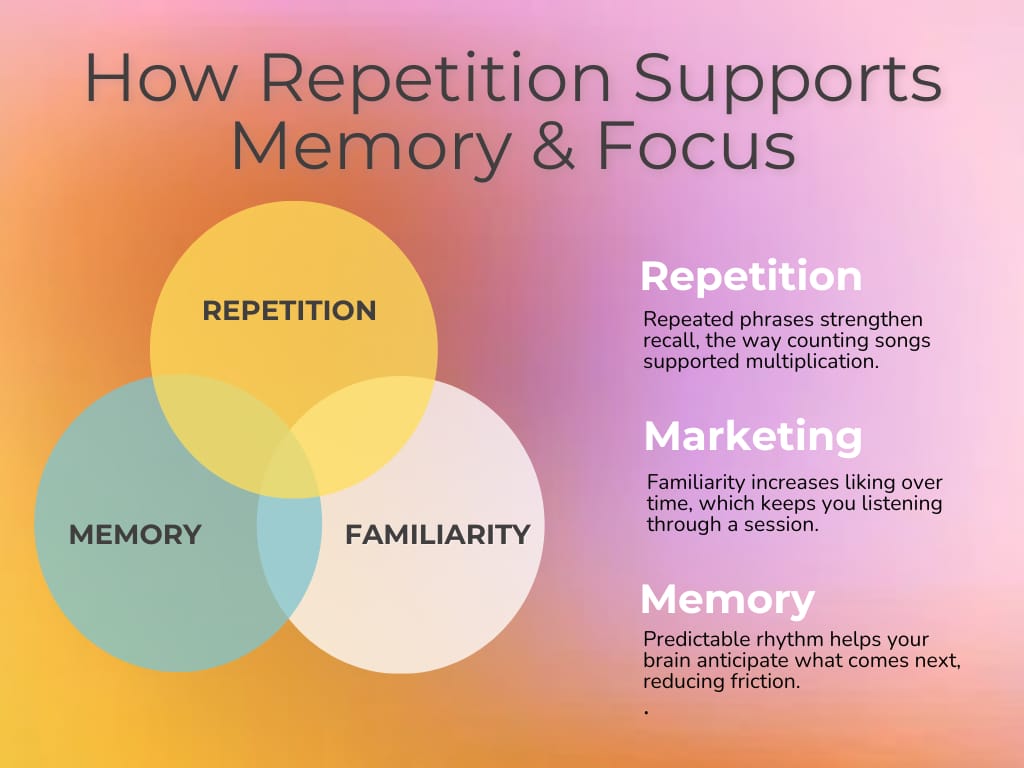When A Song Just Works
I learned early that melody and memory travel together. In elementary school, my teacher used a counting song for multiplication. I can still sing “3, 6, 9, 12, 15, 18...” today, and the numbers come back on cue. The rhyme and rhythm locked the sequence in place.
I grew up in church as well, singing praise and worship when life felt heavy. Positive words over uplifting chords helped me shift out of a low moment into a higher frequency. That experience shaped how I create today. Feel Good Sounds makes lyric-light, mood-lifting music for focus and flow. It is designed to help you feel good, then do good.
Repetition, Memory, and Why Songs Stick
Quick answer: Why do people like repetitive songs?
Repetition creates familiarity, which lowers processing effort and feels rewarding. Simple refrains and steady grooves become easy to follow while you work.

Repetition lowers the mental effort it takes to process a song. Familiar patterns create faster recognition, which frees attention for the task in front of you.
Repeated phrases strengthen recall, the way counting songs supported multiplication.
Familiarity increases liking over time, which keeps you listening through a session.
Predictable rhythm helps your brain anticipate what comes next, reducing friction.
Lyrics, Attention, and Cognitive Load
Quick answer: Is music with lyrics bad for studying?
For language-heavy study or writing, dense lyrics often distract because they compete with working memory. For design, drawing, or admin, light vocals may be fine if they do not demand attention.

Words carry meaning. During deep work, full lyrics compete with your inner speech — the voice you use to plan, write, or solve problems.
Tasks that rely on language, like writing or reading, benefit from fewer words in the background.
For visual or manual tasks, light vocals may still work if the message is simple and positive.
Repetition, Memory, and Why Songs Stick
Lyric-light means simple, short phrases that function like mantras, paired with grooves that keep momentum. It keeps the emotion of the human voice, without pulling you out of flow.
Quick answer: Why do people like repetitive songs?
Repetition creates familiarity, which lowers processing effort and feels rewarding. Simple refrains and steady grooves are easier to track while you work, so attention drifts less and focus lasts longer.
The Case For Lyric-Light Music
Quick answer: What is lyric-light music?
Music with minimal, simple phrases and no dense verses. It supports mood and rhythm without heavy verbal content, so you can stay on task.
Lyric-light means simple, short phrases that function like mantras, paired with grooves that keep momentum. It keeps the emotion of the human voice, without pulling you out of flow.
Why it helps:
A small number of words, repeated with intention, becomes calming rather than noisy.
Positive language steers mood and self-talk in a helpful direction.
You keep the warmth of a voice while protecting focus.
ADHD, Familiarity, and Emotional Regulation
Does music help ADHD focus?
Quick answer: Many people with ADHD report better task initiation and sustained attention with structured, familiar music. The steady pattern supports regulation. Results vary by person and task.
Full explanation...
For many ADHD listeners, predictable rhythm and familiar refrains help regulate attention and emotion. Music can lift energy when motivation dips, or steady energy when anxiety rises. It becomes a tool for state-shifting.
From my experience, the right playlist helps you start, continue, and finish. Flow feels like a path you can see, not a maze you keep restarting.
Flow State and Creative Work
How to Use Music with the Pomodoro Technique
Quick answer: How do you use music with the Pomodoro technique?
Choose a 30-minute or 1-hour timer and pair it with a lyric-light playlist. Work until the timer ends, then take a short 5-10 minute break. Repeat for 3–4 cycles to stay in flow without burning out.
“Groove through your grind — make routine work feel lighter.”
When music works, you feel it. Focus becomes efficient. You are not juggling ten tabs. You start, you find a middle, you finish. You move toward a clear goal, and the groove carries you.
This is why I design tracks with different flows of the same message. Some songs use one or two flows. Others explore three or four. The tone stays positive and the mantra remains the same.
Pick a lyric-light playlist.
Set a 25-minute timer, then a 5-minute break.
Repeat four cycles.
Switch to a calmer mix for the final hour if you work at night.
Task fit
Writing or reading → fewer words, lower dynamic range.
Design or editing → more movement allowed.
Errands or workouts → upbeat, positive tracks for energy.
FAQ: Music, Focus, and Flow
Short, repeated phrases imprint through rehearsal in memory. Emotional context strengthens the imprint.
Lyric-light, familiar grooves, steady tempo, minimal surprises. Enough movement to feel alive, not so much that it steals attention.
You start quickly, remain on one task, finish with less friction. Your mood lifts, your energy feels steady, your tabs stay closed.
/Final Takeaway
Music is not filler. It is design for your state of mind. When it feels like a sunny day, when it brightens you, when it gives you clarity, keep it. Build a soundtrack for the life you are building.
Feel Good Sounds makes drops, which are playlists with intention. A drop is a message you place into your subconscious: positive words, simple flows, grooves that help you move.
👉 Join Feel Good Sounds
Need music that actually helps you focus?
Join Club Feel Good and get access to our exclusive lyric-light playlists for deep work. New drops every Sunday at 6 pm ET.

